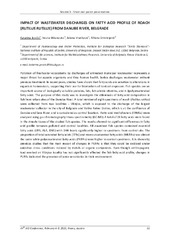Приказ основних података о документу
Impact of wastewater discharges on fatty acid profiles on roach (Rutilus rutilus) from Danube River, Belgrade
| dc.creator | Jovičić, Katarina | |
| dc.creator | Đikanović, Vesna | |
| dc.creator | Vranković, Jelena | |
| dc.creator | Dimitrijević, Milena | |
| dc.date.accessioned | 2023-03-07T11:19:31Z | |
| dc.date.available | 2023-03-07T11:19:31Z | |
| dc.date.issued | 2023 | |
| dc.identifier.uri | https://www.oen-iad.org/congress2023/documents/conference%20book_44th_iad%20conference_2023.pdf | |
| dc.identifier.uri | http://radar.ibiss.bg.ac.rs/handle/123456789/5488 | |
| dc.description.abstract | Pollution of freshwater ecosystems by discharges of untreated municipal wastewater represents a major threat for aquatic organisms and thus human health. Serbia discharges wastewater without previous treatment. In recent years, studies have shown that fatty acids are sensitive to alterations in organism homeostasis, supporting their use for biomarkers of toxicant exposure. Fish species are an important source of biologically valuable proteins, fats, fat-soluble vitamins, and n-3polyunsaturated fatty acids. The purpose of this study was to investigate the diferences of fatty acid composition in fish from urban sites of the Danube River. A total number of eight specimens of roach (Rutilus rutilus) were collected from two localities - Višnjica, which is exposed to the discharge of the largest wastewater collector in the city of Belgrade and Veliko Ratno Ostrvo, which is at the confluence of Danube and Sava River, and is considered as control location. Fatty acid methyl esters (FAMEs) were analyzed using gas chromatography–mass spectrometry (GC-MS). A total of 28 fatty acids were found in the muscle tissue of the studied fish species. The results showed no significant differences in fatty acid profile between polluted and control localities. All examined fish species contained essential fatty acids (EPA, ALA, DHA) with DHA levels significantly higher in specimens from control site. The proportion of total saturated fatty acids (SFAs) and monounsaturated fatty acids (MUFAs) was almost the same while polyunsaturated fatty acids (PUFAs) were higher in control specimens. It is shown by previous studies that the main reason of changes in PUFAs is that they could be oxidized under oxidative stress conditions induced by metals or organic compounds. Even though anthropogenic load exerted on Višnjica locality has not significantly affected the fish fatty acid profile, changes in PUFAs indicated the presence of some xenobiotics in their environment. | sr |
| dc.language.iso | en | sr |
| dc.publisher | Austrian Committee - International Association for Danube Research | sr |
| dc.relation | info:eu-repo/grantAgreement/MESTD/inst-2020/200007/RS// | sr |
| dc.rights | openAccess | sr |
| dc.source | Conference Book: 44th IAD conference: Tackling Present & Future Environmental Challenges of a European Riverscape; 2023 Feb 6-9; Krems, Austria | sr |
| dc.subject | roach | sr |
| dc.subject | impact of pollution | sr |
| dc.subject | fatty acids | sr |
| dc.subject | urban area | sr |
| dc.subject | Danube River | sr |
| dc.title | Impact of wastewater discharges on fatty acid profiles on roach (Rutilus rutilus) from Danube River, Belgrade | sr |
| dc.type | conferenceObject | sr |
| dc.rights.license | ARR | sr |
| dc.rights.holder | © 2023 by the Austrian Committee - International Association for Danube Research | sr |
| dc.description.other | Conference Book: 44th IAD conference: Tackling Present & Future Environmental Challenges of a European Riverscape; 2023 Feb 6-9; Krems, Austria. Austrian Committee - International Association for Danube Research; 2023. p. 31. | sr |
| dc.citation.spage | 31 | |
| dc.type.version | publishedVersion | sr |
| dc.identifier.fulltext | https://radar.ibiss.bg.ac.rs/bitstream/id/12462/bitstream_12462.pdf | |
| dc.citation.rank | M34 | |
| dc.identifier.rcub | https://hdl.handle.net/21.15107/rcub_ibiss_5488 |

